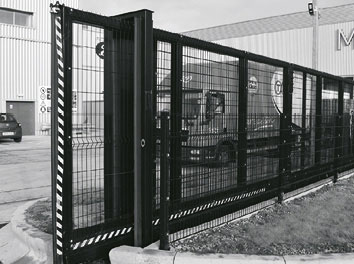 Automated gates are a regular feature on commercial properties. However, these gates are legally defined as machines, and as such, if the appropriate safety protocol is not adopted, they are capable of inflicting serious injury and ultimately can cause a fatality, warns Rob Williams, Technical and Training Manager, Gate Safe
Automated gates are a regular feature on commercial properties. However, these gates are legally defined as machines, and as such, if the appropriate safety protocol is not adopted, they are capable of inflicting serious injury and ultimately can cause a fatality, warns Rob Williams, Technical and Training Manager, Gate Safe
Since the inception of Gate Safe in 2010, there have been positive developments in terms of an improved awareness of the required safety features for automated gates that should be present on any installation. But, there still remains a degree of ignorance in relation to the steps that need to be taken to create a gate that has been designed with safety as the primary consideration. The growing number of falling gates accidents is an indication of the dangers associated with a failure to apply a ‘safety by design’ approach – so avoiding the consequences of a single point failure. Court cases following fatalities caused by falling gates have resulted in fines as high as £500,000. Simply following the British Standards will not ensure a safe and compliant installation as stated by the HSE.
Facilities managers will be bound by a legal responsibility to check the ongoing safety of any automated gates or barriers on site – these gates must be safe to use and regularly maintained according to the Health and Safety at Work Act 1974 / Workplace (Health, Safety and Welfare) Regulations 1992 and as advised by the HSE.
GUIDANCE FOR FACILITIES MANAGERS
Any facilities manager who assumes responsibility for a site where automated gates or barriers are present who has yet to experience any kind of accident associated with these installations should not be complacent.
First ask the question, have these gates been regularly maintained? This is a legal requirement and you will be held accountable in the eyes of the HSE if an accident does occur that is linked to poor maintenance of the installation. Records should exist defining when the gates were last checked.
The next question should be, was the person who checked the gates suitably trained and competent? They should have undergone specialist training to understand the dangers associated with these installations, and the steps that must be taken to mitigate any risks. A thorough risk assessment should have been conducted at each maintenance visit and there should be clear evidence of this.
 Assessments should always be conducted with an open mind. While no-one is keen to admit that they’ve made a mistake it’s important to acknowledge that sometimes important risks are missed, especially if the person had not undergone adequate training. The focus should always be on accepting that mistakes can be made, but not to compromise on the safety of the installation going forward.
Assessments should always be conducted with an open mind. While no-one is keen to admit that they’ve made a mistake it’s important to acknowledge that sometimes important risks are missed, especially if the person had not undergone adequate training. The focus should always be on accepting that mistakes can be made, but not to compromise on the safety of the installation going forward.
If there is a dispute between what the original installer is saying, and the subsequent maintenance provider in terms of any risks associated with the installation, always seek out an independent assessment of the gate to reach a definitive conclusion. Gate Safe operates a site survey service and is regularly called upon to provide an unbiased review of a gate when this type of situation occurs.
Also check if the gate is CE/UKCA marked which will ensure it was deemed legally compliant when installed. As part of this process, the duty holder should be provided with handover pack and training on how to use the gate and a copy of the declaration of conformity. This should include an understanding of the location of the manual release key – and how to use it in the event of an emergency.
PRACTICAL CHECKS
All safety edges and photocells should be fail safe, meaning they won’t work in the event of a problem. However, always check that the safety devices are in good working order. Edges should be well attached to the gate (not hanging off or no longer in the correct position) and photocells should be clean and free from any obstructions
If the gate is not operating smoothly, take action. This can be indicative of a bigger problem and should be investigated. Never ignore any indications that the gate is not working properly and report any faults or malfunction immediately.
Check hinges for general wear and tear and look for any signs of corrosion build up on the system.
Be aware that any changes in the site can represent a new risk not identified in the previous risk assessment, a risk which must be mitigated. For example, if a new wall has been added adjacent to the gate this can create a crushing point. Or, if there has been a change in the camber of the road or driveway this may result in an unacceptable gap below the gate.
Can the power for the gate be easily isolated before going near it? This is an essential requirement for a safe system.
HAS THE SITE USAGE CHANGED?
Finally, it is important to check if the maintenance visits are in line with the usage of the machine, as defined by the gate installer – Gate Safe advises a minimum of checks every six months and BS EN 12453:2017 states that all electronic safety devices should be checked every six months.
Ultimately, you should always consider does this site still need an automated gate or are there other means to effectively secure the area?
In association with https://gate-safe.org





